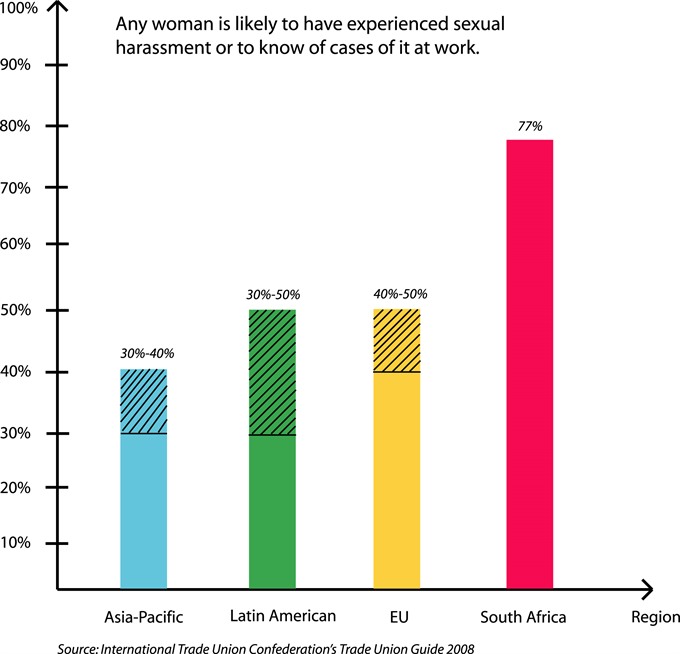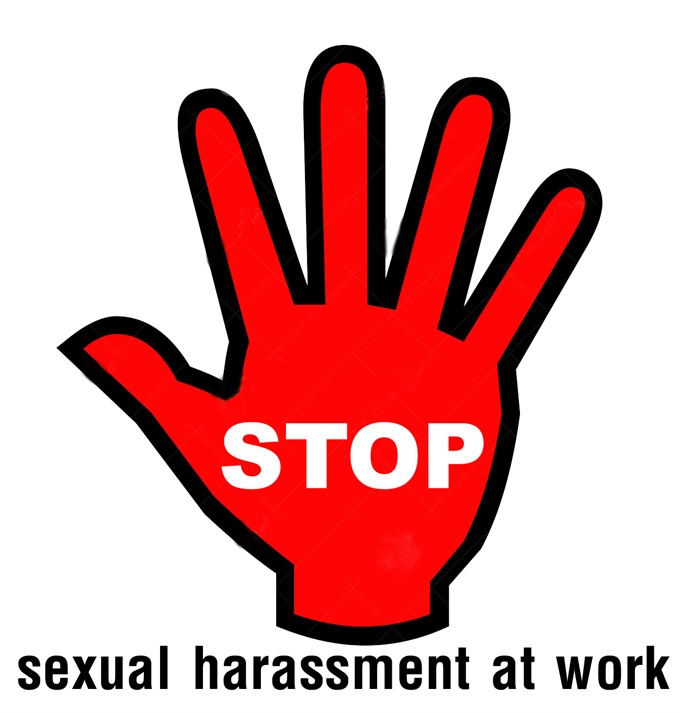 Society
Society

The issue of sexual harassment in the workplace - an often subtle but disturbing form of aggression – is increasingly troubling without actions taken to stop it
 |
| Sexual harassment include physical, verbal and non-verbal forms. — VNS Photo Mai Khuê |
by Nguyễn Khánh Chi
Mai, an office cleaner, was groped by an official as she worked. When this happened several times, she had a video taken of the act, and lodged a sexual harassment complaint with authorities in Cà Mau Province.
Then something worse happened. The official escaped the scandal almost unscathed, and Mai (not real name) quit her job. It is not known whether she will pursue further legal action, but her plight is not uncommon.
In fact, Mai is among very few victims of sexual harassment at work that dare to speak out, especially in countries like Việt Nam where a feeling of shame, a fear of losing dignity and the job are pervasive.
However, existing legal tools and work culture are not sufficient to protect her.
The striking fact is that not a single case of sexual harassment has been brought to court in Việt Nam. Worse still, the Tiếng Chuông – a webpage of the National Committee for AIDS, Drugs and Prostitution Prevention and Control, reports that no one has even been fined for this offence.
One study on sexual harassment at the workplace in Việt Nam, done by the Ministry of Labour, Invalids and Social Affairs (MOLISA) and the International Labour Organisation (ILO), found that the fear of reprisals prevents most victims from speaking out, let alone lodge a formal complaint.
Many only seek help or report their troubles only when harassment escalates to serious sexual assault, or after they move to different jobs.
The new Labour Code, which took effect in May 2013, prohibits sexual harassment at workplaces for the first time, but it neither defines the offence clearly nor prescribes specific punishments.
“Right now, the Labour Code only has a provision that mentions sexual harassment is prohibited, but it doesn’t clearly define what sexual harassment is and it doesn’t define what sanctions are,” said UN Women Country Representative in Việt Nam, Shoko Ishikawa.
“Relevant regulations are too general without pointing out what specific acts can be considered sexual harassment. This has led to difficulties in preventing and handling of violations,” said Trịnh Thanh Hằng of the Việt Nam General Confederation of Labour (VGCL).
“As far as I’m concerned, victims of sexual harassment do not want to report harasser’s actions because they are more vulnerable, when compared to men, and afraid of losing their job. They also find it hard to gather sufficient evidence to show they are harassed at work,” Hằng said.
Since a Code of Conduct on Sexual Harassment in the Workplace was passed in May, 2015, not a single case has been brought to court, Hằng added.
The code of conduct was introduced by MOLISA in co-ordination with VGCL and the Việt Nam Chamber of Commerce and Industry (VCCI). It aims to close legal loopholes in addressing the issue and serves as a foundation for employers to prepare policies or regulations that help secure a safe working environment.
In 2013, MOLISA proposed fines of VNĐ50-75 million (US$2,200 -3,300) for sexual harassment acts in a draft decree on handling labour violations. However, the proposal has not been approved because the violations are not clearly defined.
 |
“Sexual harassment” is defined in the Code of Conduct as any behaviour of a sexual nature that affects the dignity of women and men, that is unwanted, unacceptable, inappropriate and offensive to the recipient, and that creates an intimidating, hostile, unstable or offensive work environment.
The code clarifies forms of sexual harassment as physical, verbal and non-verbal, to help workers recognise sexual harassment and protect themselves.
In fact, there is a tendency to confuse sexual harassment at the workplace with insensitive comments.
“Sexual harassment comes in many forms and its victims are often reluctant to report because they think such misconduct is a cultural norms,” the MOLISA-ILO study quoted a male government official as saying.
“I think sexual harassment has to be something serious, like rape. Once, I was suddenly embraced from behind by a male colleague, I tried to push him away and asked him what he was doing,” said a Government employee in Hà Nội.
“I did not think it was something serious, although I completely objected to the action. I just thought he was teasing me, just that.”
Sexual harassment does not affect women alone; men can also be victims. However, women are more vulnerable.
The majority of victims of sexual harassment at work in Việt Nam are female, 78.2 per cent against 21.8 per cent of male victims, said Nguyễn Thị Vân of the MOLISA’s Legal Affairs Department.
In a study on sexual harassment in the workplace in Asia, Sapana Pradhan-Malla of Nepal’s Forum for Women, Law and Development, said “Women are vulnerable to the harassment because they lack similar power, lack self-confidence and are socialised that they are to suffer in silence. Sexual harassment is also used as a tool to discourage women who may be seen to be competing for power.”
Global research has shown that sexual harassment negatively affects the working environment, undermines gender equality at work, creates unfair treatment in employment and adversely impacts the dignity and well-being of workers, said ILO Vietnam’s Labour Law Advisor Anne Boyd.
“It creates psychological anxiety and stress for victims and if ignored, can result in high costs for companies through loss of productivity, low worker morale, absenteeism, and staff turnover,” Boyd said.
In addition to the damaging psychological and physical affects sexual harassment can have on victims, it can negatively affect workplace communication and overall factory productivity, according to a research related to workplace sexual harassment by Better Work Việt Nam.
“It hinders women from being productive as they have to work in places of fear, often absent themselves from work or choose to leave the job they have,” said Ishikawa from UN Women.
 |
| Sexual harassment is unacceptable as it creates an intimidating, hostile, unstable or offensive work environment. — Illustration by painter Minh Trí |
The 2013 MOLISA-ILO study said statistics and official figures on sexual harassment in Việt Nam are not readily available.
“However, the information gleaned from mass media highlights that sexual harassment is widespread at workplaces. This suggests that although sexual harassment persists in the Vietnamese society, it suffers from inadequate attention,” it said.
Another MOLISA-ILO study in 2012 found it was predominantly women aged between 18 and 30 who experienced sexual harassment, and the victims usually occupied lower-ranking positions under the supervision of the perpetrator.
An earlier study, “Research on Decent Work for Domestic Workers in Việt Nam,” conducted by the Institute for Family and Gender Issues, also noted that while sexual harassment at workplace can happen to individuals in all age groups, the risks are higher for young people between 18 and 30 years.
“We know from our work that sexual harassment occurs in Việt Nam; unfortunately, there is very limited official statistics on it. More research is needed to really understand how common this type of behaviour is,” Boyd said.
Boyd said that in 2015, the ILO and Navigos Search conducted a survey focused on gender equality in recruitment and promotional practices, which provided further insights into the problem.
Seventeen per cent of the candidates for mid-career posts said that either they or someone they know have been asked for “sexual favours by a superior in return for some kind of workplace benefit.
“This type of behaviour constitutes sexual harassment and provides one example of the invidious situation that victims can face when their aim is simply to obtain a job or progress beyond their current role.”
Nguyễn Vân Anh, Director of Centre for Studies and Applied Sciences in Gender, Family, Women and Adolescents (CSAGA), said research has shown that sexual harassment in the workplace was real problem in the country.
A study carried out by children’s rights organisation PLAN found 87 per cent of women in Hà Nội and HCM City suffering all forms of sexual harassment in public places, Anh said. In a study by CSAGA last year, 14 per cent of schoolgirls in 30 schools said they had suffered sexually harassment.
“Women and girls will always feel unsafe in an environment where they are considered as a sex toys and where the dignity of women is lowered, which severely affects gender equality in Việt Nam.
“Sometimes women are blamed for creating the conditions for men to commit sexual harassment, so victims find it hard to speak out. Additionally, how the law can strictly deal with acts of sexual harassment when the definition of these acts remains unclear?” Anh said.
“Even more dangerous, when acts of sexual harassment are underestimated, other serious acts committed towards women such as violence, sexual violence will also be slightly examined.”
 |
“First, there is a lack of a thorough understanding of sexual harassment at work. Victims do not know if an act is sexually oriented and harassers also don’t know whether their actions are allowed or not,” said MOLISA Deputy Minister Nguyễn Trọng Đàm.
“Second, competent authorities don’t strictly abide by legal provisions. Thus, it is essential to strengthen communication to raise public awareness and improve working conditions to eliminate risks of being harassed. Also, increased examinations and sanctions are important,” Đàm said.
Anh of CSAGA said sex education was vital to equip the young people with knowledge and awareness, but this is a long-term target.
“The workers have to learn how to say NO to sexually suggestive stories or pictures that they do not want to see and hear. Any touch or comments on sensitive parts of one’s body must be rejected and warnings given to stop; (victims) should not remain silent,” Anh said.
ILO’s Boyd said it was important to raise awareness of what constitutes sexual harassment and the impact it has on individuals (both women and men), their families and the workplace.
“Sexual harassment comes at a high cost to everyone. It is important that strong legal provisions are put in place in this area as a clear signal that such behaviour is unacceptable.
“However, beyond this, the Government, employers, organisations and trade unions, as well as the media, need to support this effort by communicating to all audiences that sexual harassment is unacceptable.” — VNS